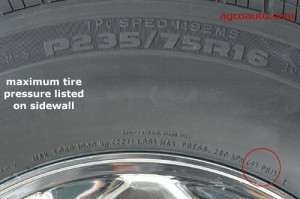Truth: Number listed shows maximum pressure allowed for that tire
The government estimates that only nine percent of vehicles have four properly inflated tires, so it’s time to clear up a myth or two about tire inflation. If you’re unsure about how to determine proper tire inflation for your tires, then here’s one piece of advice: DO NOT go by the number on the sidewall.
Sidewall tire markings (shown left) are found around the circumference of a tire, indicating everything from the brand and the wheel diameter to the load index, speed rating, tread wear, and traction. The pressure label (circled in red) does not indicate the manufacturer’s recommended tire inflation pressure, nor does it indicate the proper air pressure based on the vehicle the tire is mounted on. The number is the maximum pressure allowed for that tire. For the recommended tire inflation pressure, check the label located on the driver’s door or the owner’s manual.
Properly inflated tires can improve fuel efficiency by 3.3 percent and save $.06 a gallon at the pump. Approximately 1.2 billion gallons of fuel are wasted each year by motorists driving on under inflated tires. The National Highway Traffic Safety Administration estimates that under inflated tires contribute to more than 600 fatalities and 33,000 injuries each year.
All this information and statistical data may be a lot to take in, so on easy way to maintain proper tire pressure longer is with nitrogen tire inflation. Nitrogen tire inflation is exactly what the name says: putting nitrogen into your tires instead of air. Studies have shown that this method of tire inflation maintains proper tire pressure longer than regular air, and keeps them in better health for a longer period of time. Who says we have to change the entire car to improve safety and fuel efficiency? Why not do just one thing differently?
To learn more about nitrogen tire inflation and finding a station near you, check out Nitrofleet99. Don’t worry if you’ve never done this before, as it’s not necessary for you to remove all the air from your tires before inflating them with nitrogen.






